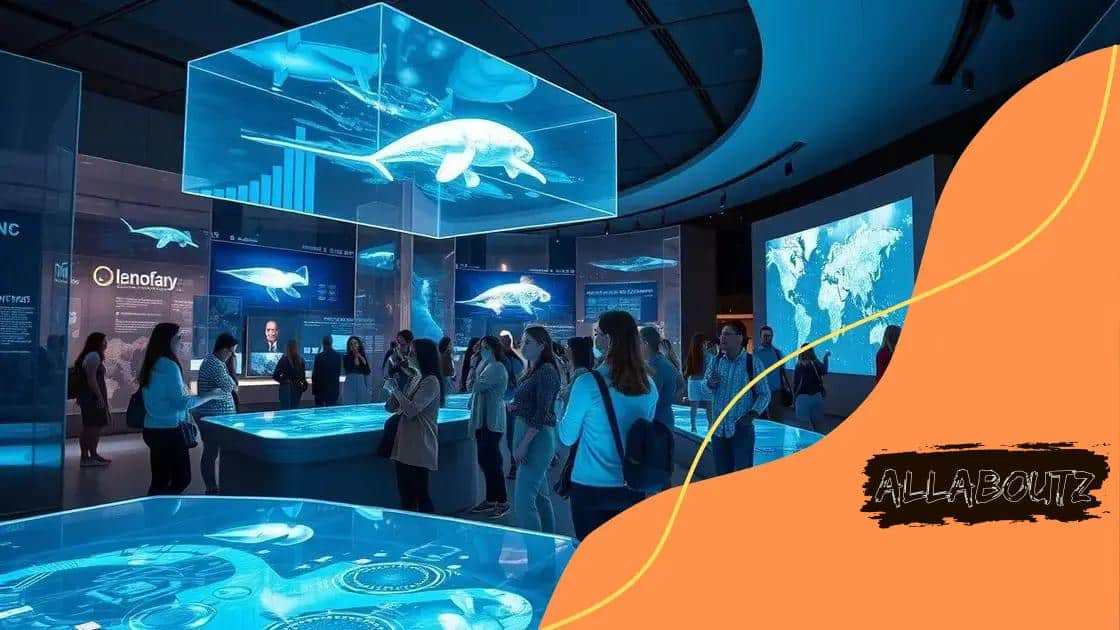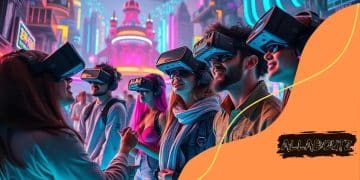Augmented reality in museum exhibitions transforms the experience

Augmented reality in museum exhibitions transforms visitor experiences by providing interactive, personalized, and engaging content, while also presenting challenges such as cost and technology integration.
Augmented reality in museum exhibitions is changing how we experience art and history. Imagine walking through a gallery and having the ability to see lifelike animations of historical events or interacting with 3D models of artifacts right before your eyes. This fascinating technology engages visitors like never before.
Understanding augmented reality
Understanding augmented reality (AR) is essential to grasp its impact on various fields, especially in museums. This technology merges the real world with digital elements, creating an enhanced user experience that captivates visitors.
How does augmented reality work? AR utilizes digital devices, like smartphones and tablets, to overlay information or images on the physical environment. This means visitors can point their devices at an exhibit and see additional content, such as videos or 3D models, that provide deeper insights into the displayed items.
The key components of augmented reality
There are several important components to consider:
- Hardware: Devices like smartphones and AR glasses are essential for delivering AR experiences.
- Software: Applications designed specifically for AR enhance how users interact with physical exhibits.
- Content: High-quality, engaging content is critical for capturing visitor interest and providing valuable information.
As museums incorporate AR into their exhibitions, they also face challenges, such as ensuring accessibility for all visitors. While some may be eager to explore these innovations, others might find the technology overwhelming. It’s important for museums to provide adequate support and guidance, making it easier for everyone to experience the benefits of augmented reality.
Popular examples of augmented reality in museums
Several museums worldwide have embraced AR. These are a few notable examples:
- The Smithsonian uses AR to bring artifacts to life with supplemental information and animations.
- The British Museum has implemented AR apps that enhance the visitor experience by providing historical context in real-time.
- The Louvre features AR elements that allow visitors to immerse themselves in the stories behind the art pieces.
Such applications demonstrate how augmented reality can transform the museum experience, making it more interactive and informative.
The role of augmented reality in enhancing exhibits
The role of augmented reality in enhancing exhibits is transformative. AR provides a unique way to engage audiences by integrating digital elements with real-world artifacts. This interaction creates a more immersive and educational experience for visitors.
By using AR, museums can present information in a way that is captivating and easy to understand. Instead of static displays, visitors can enjoy dynamic content that brings history and art to life.
Benefits of augmented reality in exhibits
There are several key benefits when implementing augmented reality in museum exhibits:
- Interactive Learning: Visitors can engage with exhibits through quizzes, animations, and detailed 3D models, making history more relatable.
- Enhanced Understanding: AR can provide context about exhibits, showing how artifacts were used or created during their time.
- Increased Accessibility: Digital content can reach a broader audience, including those who may not visit in person.
As visitors explore the exhibits, they can unlock stories that were previously hidden from view. For instance, viewing a Renaissance painting through an AR app might reveal additional layers, such as the artist’s techniques and influences.
Case studies of successful AR integration
Many museums have successfully integrated AR into their exhibits:
- The National Museum of Natural History uses AR to show the evolution of species in real-time.
- The Tate Modern enhances its modern art exhibits by allowing users to dissect and interact with artworks.
- The Smithsonian’s AR apps create a virtual tour that offers richer narratives about their collections.
These innovations not only attract more visitors but also provide a chance for deeper learning. The fusion of technology with culture makes visits exciting and memorable.
Examples of successful augmented reality installations

There are many examples of successful augmented reality installations around the world that highlight the technology’s potential to enhance visitor experiences. These installations not only engage audiences but also educate them in exciting new ways.
One prominent example is the Van Gogh Museum in Amsterdam. Here, visitors can use AR to interact with the artist’s paintings. Through their devices, they experience vivid animations that bring Van Gogh’s artwork to life, displaying scenes of his inspiration.
The British Museum’s AR Experience
The British Museum has also embraced AR technology. With its app, visitors can point their smartphones at specific artifacts and see additional content. This includes videos and historical information that enrich the story behind each piece. This kind of engagement keeps people interested and helps them remember what they learn.
The Museum of Modern Art (MoMA)
At MoMA, augmented reality enhances the exploration of modern art. Visitors can view sculptures and paintings from different angles by scanning them with their phones. The AR application provides additional context on the artists and their techniques. This interactive approach makes art more accessible to everyone.
The National Gallery’s Art Layer
The National Gallery in London features an innovative AR exhibit called Art Layer. This installation allows users to interact with famous paintings such as The Fighting Temeraire by Turner, overlaying details about the artwork and the artist’s life. Visitors can gain insights into the story behind the art while enjoying a unique visual experience.
These successful installations show how augmented reality can enhance the museum experience. By combining the digital world with real artifacts, museums create engaging narratives that educate and captivate visitors.
Challenges of implementing augmented reality in museums
Implementing augmented reality in museums presents several challenges that must be carefully navigated. While the technology offers exciting opportunities, it can also introduce complexities that museums need to address.
One major challenge is cost. Developing AR applications can be expensive, requiring significant investment in technology and content creation. Museums often operate on tight budgets, making it difficult to allocate resources for such innovations.
Technical Integration
Another challenge involves technical integration with existing infrastructure. Museums must ensure that their current systems can support AR technologies. This includes reliable Wi-Fi, compatibility with various devices, and a user-friendly interface that visitors can easily navigate.
Visitor Engagement
Moreover, engaging visitors with AR content can be a hurdle. Not all visitors are familiar with the technology, so museums need to provide clear instructions and assistance. Ensuring that the experience is enriching rather than confusing is essential for visitor satisfaction.
Content Creation
Creating high-quality AR content is another significant challenge. Museums need to collaborate with skilled developers and designers who understand both the technology and the subject matter. There is a constant need for fresh content to keep the experience exciting and relevant.
Additionally, museums must consider the diverse needs of their audiences. AR experiences should be accessible to people of all ages and backgrounds, including those with disabilities. This is crucial for ensuring that everyone can enjoy and learn from the exhibits.
Tackling these challenges requires careful planning and collaboration among museum staff, technology experts, and content creators. Overcoming these hurdles can lead to a successful integration of augmented reality, ultimately enhancing the museum experience for all visitors.
Future trends in augmented reality for exhibitions
The future trends in augmented reality for exhibitions are exciting and promise to change how museums engage with visitors. As technology evolves, AR will become even more integrated into the museum experience.
One trend is the enhancement of interactive experiences. Museums are likely to create more immersive environments where visitors can interact with exhibits in real-time. This could include touchpoints where users manipulate digital content with gestures.
Personalization of Content
Another future trend involves the personalization of content. Using visitor data, museums can tailor experiences to individual preferences. For example, when a visitor scans an artwork, they might receive information relevant to their interests, such as detailed stories about the artist or related pieces in the collection.
Integration of Artificial Intelligence
The integration of artificial intelligence (AI) with AR technology will enhance how exhibits are presented. AI can analyze visitor interactions and adapt the AR content in real-time. This means that if a visitor shows interest in a specific theme, the AR experience can expand to include related information and artifacts instantly.
Collaboration across Disciplines
Future AR exhibitions will likely involve more collaboration across disciplines. Museums may work with tech companies, artists, and educators to develop engaging AR content. This collaboration can lead to innovative exhibits that blend art, science, and technology seamlessly.
Moreover, as more museums adopt AR, the competition for attention will increase. This will push institutions to continuously innovate, ensuring that visitors have unique experiences that encourage repeat visits.
The future of augmented reality in museums appears bright. With advancements in technology and creative approaches, exhibitions will become more engaging, stimulating, and educational, enhancing the overall visitor experience.
FAQ – Questions about Augmented Reality in Museums
What is augmented reality?
Augmented reality (AR) is a technology that overlays digital information, such as images or sounds, onto the real world, enhancing the way we interact with our environment.
How does AR improve visitor engagement in museums?
AR provides interactive experiences that allow visitors to engage with exhibits in innovative ways, making learning more immersive and enjoyable.
What challenges do museums face when implementing AR?
Museums may encounter challenges like high costs, technical integration with existing systems, and ensuring that all visitors can effectively use the technology.
What are some future trends for AR in museums?
Future trends include personalized content based on visitor preferences, increased integration of artificial intelligence, and more collaboration across disciplines to create unique exhibits.





